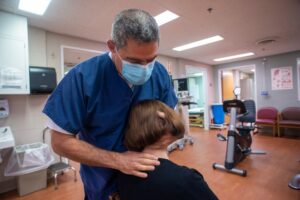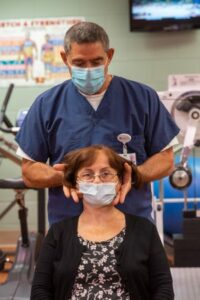You’re ready to return to the office after more than a year working at home. But is your body?
Even before COVID-19, Matt Shaw was starting to feel weird twinges of pain in his neck and shoulders at work.
But soon after he switched from a standing desk and computer monitor at the office to either the kitchen table or a 1950s-era desk and his laptop at home during the pandemic, he noticed a big difference in his discomfort.
“Once we were 100% remote, it just escalated,” said Shaw, 45, a Bristol resident who works in sales for a Montgomery County IT recruiting firm.
The transition from a full-time, face-to-face work world to a virtual one was an experience shared by millions of American workers during the 2020 COVID-19 pandemic, when widespread stay-at-home orders closed businesses and sent employees into self-isolation.
But many home environments contributed to bad habits that physically changed bodies. The result is a deconditioned workforce that can impact productivity, product quality and injury claims once employees return to the office full time, medical and ergonomic experts said.
“Some people went from a completely ergonomic desk and $1,000 chair and then went home working at the kitchen table,” said Ron Wiener, CEO of iMovR, which manufactures active office workstations.
The ergonomic industry saw explosive growth during the pandemic as more companies sought to promote active home workstations for employees realizing that they were still a potential workplace injury liability, Wiener said.
Reduced physical activity can quickly have a significant negative impact on the human body, especially among older people, medical experts said. A prolonged sedentary lifestyle can result in reduced cardiovascular fitness, muscle strength, flexibility, and endurance especially when weight gain, a common experience during pandemic-related lockdowns, is added.
The result is a body more prone to fatigue and experiencing muscle strain and soreness quicker when faced with a return to pre-pandemic work environments, physical therapy and ergonomics experts said. At greatest risk are employees whose jobs involve physical labor.
Suboptimal workstations lead to health issues
Once they return to a pre-pandemic work environment, those employees could notice a greater diminished performance capacity, said Lisa Orr, a professional ergonomics expert and senior consultant at Sedgwick, a leading claims management solutions provider. People who’ve had COVID and older workers may require more time to recoup pre-pandemic stamina levels.
Other employees that Orr worries about are the ones who worked at home for longer than a year in suboptimal workstation setups who may have developed bad habits to compensate for the lack of ergonomically correct equipment.

The University of Cincinnati evaluated the home workstations of more than 800 university employees during the pandemic and identified many issues that could be adversely affecting home-bound workers.
Many chairs were the wrong height, often too low and without any lumbar support, so they did not provide proper lower back support, according to the 2020 study. Laptop keyboards are significantly smaller than regular-sized keyboards, which could lead to developing carpal tunnel syndrome in the wrists.
A little more than half of participating workers had armrests on their desk chairs, but most didn’t use them; in some cases they were improperly adjusted, the study found. Forearms that rest on hard work surfaces cause contact stress and strain across the upper back and arms.
Monitors built into laptop computers were often too low, resulting in eye and neck strain for users. External monitors were also routinely set up too low and off to one side, again resulting in neck strain, researchers found.
More people also have become acclimated to a sedentary lifestyle after more than a year of workdays that essentially involved getting out of bed and walking a short distance to the work computer and sitting for hours, said Doylestown Health physical therapist Lauren Direso.
“It’s such a drop in activity,” Direso said. “You wouldn’t think of the physical activity of getting to the car, walking into the building. I would anticipate that would be a complaint when more people are going back to the office.”
Muscle: Use it or lose it
The majority of patients Direso saw over the last month for muscle and joint pain were people still working from home several days a week as companies gear up for full-time return to the office.
The complaints she anticipates now are similar to ones patients had when they transitioned from office to home. Patients who created an ergonomically correct workstation at home might return to an office with subpar workspace, which can trigger neck or back pain, Direso said.
When individuals reduce their activity, the muscles get weak and don’t work to keep everything they support strong, Direso said. What that means is you can’t walk as fast, lift as much weight, move as easily. Muscle mass breaks down, and it needs to be built back up.
But rebuilding lost muscle is a slow process. The average human can lose between 1% and 3% of muscle strength each day as a result of inactivity and it takes weeks or months to regain strength and flexibility, according to HumanTech, an Michigan ergonomics consulting company.
Bristol Township resident Francis McKenna, 75, would try to get to the gym a couple times a week before the pandemic closed it for months. Even after it reopened, he avoided going back to reduce his potential COVID-19 exposure.
After a year holed up in his house, and a 10-pound weight gain, McKenna noticed a big difference in his ability to get around easily. He started physical therapy last year, but had to stop when he reached his insurance limit of 30 sessions. He resumed physical therapy in January.
“I can feel the difference. No doubt about it,” McKenna said. “Whatever condition you were in before this stuff happened, I think everyone’s condition dropped somewhat.”

Less activity means longer recovery time
Older individuals and those who were more physically inactive can also anticipate it will take longer to get back into the shape they were in before the pandemic, Lower Bucks Hospital physical therapist Jay Witkowski said.
Many had mobility issues to start with, resulting in slower gaits, higher risk of falls and depression, said Witkowski, clinical coordinator of outpatient physical therapy at the Bristol Township hospital.
Throughout the pandemic, Witkowski saw a jump in patients who were displaced workers experiencing pain related to musculoskeletal disorders as a result of poor working habits and workstation setups.
Sitting too long, especially in a poor seat position, doubles the compression on the lower back disc, resulting in neck, back and hip strain, tight glutes and hamstrings and knee problems, Witkowski said.
One patient developed shoulder and neck pain from incorrect computer mouse use after his company moved to remote working during the pandemic. He also developed knee pain as a result of his seat position,” Witkowski said.
“When your butt stops working you develop knee pain,” he said. “If you are sitting a lot, you’re going to run the potential risk (for injury) if you aren’t conditioning yourself in another way.”
People should start increasing their physical activity at least a couple weeks to a month before transitioning back to the office environment to increase stamina and endurance, Witkowski and Direso said.
Shaw sought physical therapy for his remote-working pains, which made a difference. He also purchased a second computer monitor, which he positioned at eye level, and kept up regular exercise throughout the pandemic.
He is now working at home three days a week and the rest of the time at the office, which reopened last month. In the handful of times that Shaw has been physically in the office, he hasn’t noticed any difference in how he feels.
“It’s something I’m sure I’ll recognize as the months go on.”
How to help employees prepare for restarting work after COVID-19
Post-pandemic workers may be physically deconditioned when returning to some jobs, which may increase risk of injury. HumanTech offers these ways to help employees prepare:
Ergonomics awareness training. Have employees complete general ergonomics awareness training. Workers should also know the primary musculoskeletal disorder hazards so they can identify and report ergonomics issues at their own workstation.
Review standard operating procedures. Instruct each employee to review SOP prior to restarting work. This can help workers recall all steps in the process, reduce errors and improve product quality.
Take a break. Encourage employees to take breaks throughout the day. Breaks from physical activity allow time for muscle recovery.
Limit overtime hours. Prevent additional physical stress by limiting overtime hours or allowing employees to work fewer hours.
Focus on well-being. Encourage employees to focus on personal fitness and overall well-being during their personal time. Encourage daily walks to maintain cardiovascular fitness and at-home workouts to maintain muscle strength.
Proactively communicate physical discomfort. Encourage employees to speak up to a supervisor when they experience physical discomfort. This communication can help identify issues and address them before they progress to a musculoskeletal disorder.


